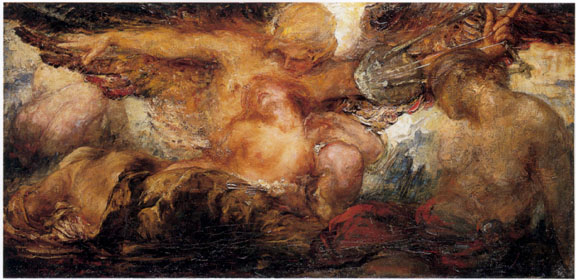
Orpheus and Eurydice by Violet Brunton RMS, 1878-1951. Oil on canvas: 18 x 36 1/4 inches, 46 x 92 centimetres. Painted c. 1910.
Set in an elegantly carved frame, the lethargic figure of Orpheus materialises from the swirling heat and flame of the sun, holding his lyre, the sound of which could charm wild beasts, move trees and seduce women. Orpheus was the paramount God of music and poetry who braved the dark abyss of the classical underworld to rescue his wife Eurydice, who had died of a snakebite. His musical genius stayed the torments of hell and so charmed Pluto and Persephone that they granted his request on the condition that he did not look back at his wife as she followed him. Orpheus, unable to resist temptation, was tragically torn from her, spiraling up and away from the underworld as she was dragged down. This tragic end is often compared with the rising and setting of the sun: "as a light herself Eurydice reappears opposite the place where he disappeared, but is seen no more after the sun himself has fairly risen" (Greuber, 35).
References
Peter Nahum Ltd, London has most generously given its permission to use in the Victorian Web information, images, and text from its catalogues, and this generosity has led to the creation of hundreds of the site's most valuable documents on painting, drawing, and sculpture. The copyright on text and images from their catalogues remains, of course, with Peter Nahum Ltd. Readers should consult the website of Peter Nahum at the Leicester Galleries to obtain information about recent exhibitions and to order their catalogues. [GPL]